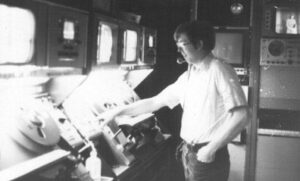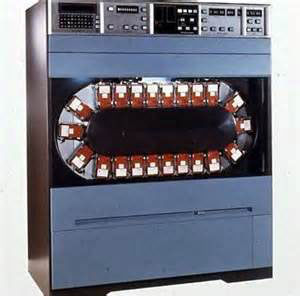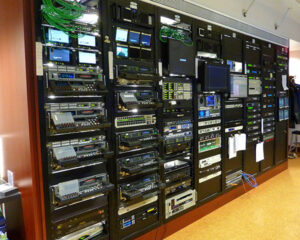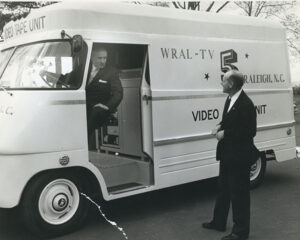
“If someone comes to me and says, ‘I’ve got this device,’ I then ask: ‘One, does it give us a better look on the air? Two, is it more reliable? Three, is it cost-efficient?’ If it doesn’t serve one of those three things, I say. ‘There’s the door. I don’t need it.’
– Julius Barnathan, President of ABC Broadcast Operations and Engineering.
 The first videotape machine purchased by WRAL-TV in the mid-50s was made by AMPEX
The first videotape machine purchased by WRAL-TV in the mid-50s was made by AMPEX
The invention of videotape fulfilled the pent-up demand to reliably and cost effectively record programming for broadcast, and it looked better on the air. The first videotape machine purchased by WRAL-TV in the mid-50s was made by AMPEX. It resembled a household appliance, like a kitchen stove or washing machine. The stout looking machine appeared to be able to take a beating and keep on ticking, but videotape tape was a bit more delicate. It was 2 inches wide with the top edge of the tape containing the audio track. The lower edge contained the control track. If the top or bottom edge was crimped to the slightest degree, that portion of the tape was damaged beyond repair. Thankfully, the tape operator could simply cut off that part of the tape and use the remaining tape on the reel. Plus, the tape was reusable; erase it and record again. As WRAL grew, so did the need for more equipment. In the late 50’s, housing one or two machines was simple, but by the late 60’s WRAL had added more machines and needed more space.
In 1970, videotape operations moved to temporary quarters in the basement of the original building. The videotape operators must have felt like they were in the engine compartment in the belly of a ship. Actually, it kind of looked like one.
 Tom Gallagher operating a Quad.
Tom Gallagher operating a Quad.
The big bulky machines, also known as “Quads” due to the four video heads used to record and playback the tape, were very noisy. Air compressors would “hiss” and “spit” when the reel-to-reel machines would spool up to speed for the tape to come down off of the supply reel to be vacuum sucked against the recording and playback heads and then pulled back up to the take-up reel. There was a constant high pitch whine as well.
 A “TCR”, also known as a Tape Cartridge Recorder, or “cart machine.
A “TCR”, also known as a Tape Cartridge Recorder, or “cart machine.
Add to that, there was another machine called a “TCR”, or Tape Cartridge Recorder, or “cart machine.” It had a revolving carousel that looked like tank treads that held red Pop Tart size boxes called “carts.” The TCR was used to play back commercials in a semi- automated fashion. During a commercial break, it would load and unload a cart every 30 seconds while the carousel would move another one into position after each playback. The tape room was so loud that videotape operators wore headsets in order to effectively communicate to master control and the control rooms.
Time marched on and video tape changed as well. The formats scaled down and quality scaled up. The old 2” VTR and TCR machines used for programming and commercials gave way to 1” machines for studio production and MII for commercial playback. News used MII as well.
 The videotape main floor at WRAL.
The videotape main floor at WRAL.
In 1987, the videotape operators were liberated from their “17 years in the dungeon” and moved up to the main floor adjacent to master control, still in the original building. Legendary engineers PB Jernigan and Al Dunbar moved and wired the equipment while the station continued to broadcast through the day without missing a beat.
 WRAL-TV’s current videotape room.
WRAL-TV’s current videotape room.
Just a few of years ago, tape operations moved again to its present location along with master control. Videotape is still hanging in there in the format of DVCPro, but its days are numbered. In fact, it has been relegated to a back-up role.
It has been a long and winding road for videotape. It served us well, and thankfully was stout enough to last until we could digitize their images into our archives.
 WRAL-TV’s first videotape truck with TV-5 GM Fred Fletcher at the wheel along with Director of Engineering Virgil Duncan.
WRAL-TV’s first videotape truck with TV-5 GM Fred Fletcher at the wheel along with Director of Engineering Virgil Duncan.
Thanks to Corp’s Pam Allen for this capcom story & these photos. Pam Parris Allen is a former WRAL newscast producer/director who now works as a researcher and producer on the CBC History Project.